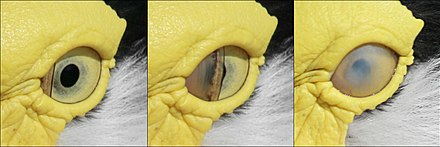
Back غشاء راف Arabic Membrana nictitant Catalan Nickhaut German Niktito Esperanto Membrana nictitante Spanish غشای پلکی Persian Vilkkuluomi Finnish Membrane nictitante French Membrana nictitante Galician העפעף השלישי HE

The nictitating membrane (from Latin nictare, to blink) is a transparent or translucent third eyelid present in some animals that can be drawn across the eye from the medial canthus to protect and moisten it while maintaining vision. All Anura[1] (tailless amphibians), and some reptiles, birds, and sharks have full nictitating membranes; in many mammals, a small, vestigial portion of the nictitating membrane remains in the corner of the eye. Some mammals, such as cats, beavers, polar bears, seals and aardvarks, have full nictitating membranes. Often called a third eyelid or haw, it may be referred to in scientific terminology as the plica semilunaris, membrana nictitans, or palpebra tertia.
- ^ Rolleston, George; Jackson, William Hatchett (1898). Forms of Animal Life : A Manual of Comparative Anatomy, with Descriptions of Selected Types. Clarendon Press. p. 401.
© MMXXIII Rich X Search. We shall prevail. All rights reserved. Rich X Search